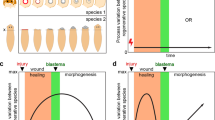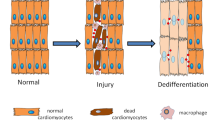Abstract
The scientific community is currently witnessing substantial strides in understanding stem cell biology in humans; however, major disappointments in translating this knowledge into medical therapies are flooding the field as well. Despite these setbacks, investigators are determined to better understand the caveats of regeneration, so that major pathways of repair and regrowth can be exploited in treating aged and diseased tissues. Last year, in an effort to contribute to this burgeoning field, Nature Medicine, in collaboration with the Volkswagen Foundation, organized a meeting with a panel of experts in regenerative medicine to identify the most pressing challenges, as well as the crucial strategies and stem cell concepts that can best help advance the translational regenerative field. Here some experts who participated in the meeting provide an outlook at some of those key issues and concepts.
This is a preview of subscription content, access via your institution
Access options
Subscribe to this journal
Receive 12 print issues and online access
$209.00 per year
only $17.42 per issue
Buy this article
- Purchase on Springer Link
- Instant access to full article PDF
Prices may be subject to local taxes which are calculated during checkout
Similar content being viewed by others
References
Schofield, R. The relationship between the spleen colony-forming cell and the haemopoietic stem cell. Blood Cells 4, 7–25 (1978).
Daley, G.Q. The promise and perils of stem cell therapeutics. Cell Stem Cell 10, 740–749 (2012).
Conboy, I.M., Conboy, M.J., Smythe, G.M. & Rando, T.A. Notch-mediated restoration of regenerative potential to aged muscle. Science 302, 1575–1577 (2003).
van Praag, H., Kempermann, G. & Gage, F.H. Running increases cell proliferation and neurogenesis in the adult mouse dentate gyrus. Nat. Neurosci. 2, 266–270 (1999).
Trejo, J.L., Carro, E. & Torres-Aleman, I. Circulating insulin-like growth factor I mediates exercise-induced increases in the number of new neurons in the adult hippocampus. J. Neurosci. 21, 1628–1634 (2001).
Fabel, K. et al. VEGF is necessary for exercise-induced adult hippocampal neurogenesis. Eur. J. Neurosci. 18, 2803–2812 (2003).
Li, W., Li, K., Wei, W. & Ding, S. Chemical approaches to stem cell biology and therapeutics. Cell Stem Cell 13, 270–283 (2013).
Sato, T. & Clevers, H. Growing self-organizing mini-guts from a single intestinal stem cell: mechanism and applications. Science 340, 1190–1194 (2013).
Watt, F.M. & Hogan, B.L. Out of Eden: stem cells and their niches. Science 287, 1427–1430 (2000).
Watt, F.M. & Huck, W.T. Role of the extracellular matrix in regulating stem cell fate. Nat. Rev. Mol. Cell Biol. 14, 467–473 (2013).
Calvi, L.M. et al. Osteoblastic cells regulate the haematopoietic stem cell niche. Nature 425, 841–846 (2003).
Friedman, S.L., Sheppard, D., Duffield, J.S. & Violette, S. Therapy for fibrotic diseases: nearing the starting line. Sci. Transl. Med. 5, 167sr1 (2013).
Engler, A.J., Sen, S., Sweeney, H.L. & Discher, D.E. Matrix elasticity directs stem cell lineage specification. Cell 126, 677–689 (2006).
Huang, N.F. & Li, S. Regulation of the matrix microenvironment for stem cell engineering and regenerative medicine. Ann. Biomed. Eng. 39, 1201–1214 (2011).
Turner, N.J. & Badylak, S.F. Biologic scaffolds for musculotendinous tissue repair. Eur. Cell. Mater. 25, 130–143 (2013).
Wong, V.W., Levi, B., Rajadas, J., Longaker, M.T. & Gurtner, G.C. Stem cell niches for skin regeneration. Int. J. Biomater. 2012, 926059 (2012).
Peerani, R. & Zandstra, P.W. Enabling stem cell therapies through synthetic stem cell-niche engineering. J. Clin. Invest. 120, 60–70 (2010).
Gómez-Gaviro, M.V., Lovell-Badge, R., Fernandez-Aviles, F. & Lara-Pezzi, E. The vascular stem cell niche. J. Cardiovasc. Transl. Res. 5, 618–630 (2012).
Palmer, T.D., Willhoite, A.R. & Gage, F.H. Vascular niche for adult hippocampal neurogenesis. J. Comp. Neurol. 425, 479–494 (2000).
Ma, J. et al. Concise review: cell-based strategies in bone tissue engineering and regenerative medicine. Stem Cells Transl. Med. 3, 98–107 (2014).
Suda, T., Takubo, K. & Semenza, G.L. Metabolic regulation of hematopoietic stem cells in the hypoxic niche. Cell Stem Cell 9, 298–310 (2011).
Titmarsh, D.M., Chen, H., Glass, N.R. & Cooper-White, J.J. Concise review: microfluidic technology platforms: poised to accelerate development and translation of stem cell-derived therapies. Stem Cells Transl. Med. 3, 81–90 (2014).
Conboy, I.M. et al. Rejuvenation of aged progenitor cells by exposure to a young systemic environment. Nature 433, 760–764 (2005).
Villeda, S.A. et al. The ageing systemic milieu negatively regulates neurogenesis and cognitive function. Nature 477, 90–94 (2011).
Villeda, S.A. et al. Young blood reverses age-related impairments in cognitive function and synaptic plasticity in mice. Nat. Med. 20, 659–663 (2014).
Katsimpardi, L. et al. Vascular and neurogenic rejuvenation of the aging mouse brain by young systemic factors. Science 344, 630–634 (2014).
Elabd, C. et al. Oxytocin is an age-specific circulating hormone that is necessary for muscle maintenance and regeneration. Nat. Commun. 5, 4082 (2014).
Maus, M.V. et al. Adoptive immunotherapy for cancer or viruses. Annu. Rev. Immunol. 32, 189–225 (2014).
Tebas, P. et al. N. Engl. J. Med. 370, 901–910 (2014).
Cutler, C. et al. Prostaglandin-modulated umbilical cord blood hematopoietic stem cell transplantation. Blood 122, 3074–3081 (2013).
Christopherson, K.W., Hangoc, G., Mantel, C.R. & Broxmeyer, H.E. Modulation of hematopoietic stem cell homing and engraftment by CD26. Science 305, 1000–1003 (2004).
Chinnadurai, R., Copland, I.B., Patel, S.R. & Galipeau, J. IDO-independent suppression of T cell effector function by IFN-γ–licensed human mesenchymal stromal cells. J. Immunol. 192, 1491–1501 (2014).
Seeger, F.H., Zeiher, A.M. & Dimmeler, S. MicroRNAs in stem cell function and regenerative therapy of the heart. Arterioscler. Thromb. Vasc. Biol. 33, 1739–1746 (2013).
Liles, W.C. et al. Mobilization of hematopoietic progenitor cells in healthy volunteers by AMD3100, a CXCR4 antagonist. Blood 102, 2728–2730 (2003).
Zaruba, M.-M. et al. Synergy between CD26/DPP-IV inhibition and G-CSF improves cardiac function after acute myocardial infarction. Cell Stem Cell 4, 313–323 (2009).
Broxmeyer, H.E. et al. Dipeptidylpeptidase 4 negatively regulates colony-stimulating factor activity and stress hematopoiesis. Nat. Med. 18, 1786–1796 (2012).
Kragl, M. et al. Cells keep a memory of their tissue origin during axolotl limb regeneration. Nature 460, 60–65 (2009).
Efe, J.A. et al. Conversion of mouse fibroblasts into cardiomyocytes using a direct reprogramming strategy. Nat. Cell Biol. 13, 215–222 (2011).
Wang H. et al. Small molecules enable cardiac reprogramming of mouse fibroblasts with a single factor, Oct4. Cell Rep. 6, 951–960 (2014).
Wang, F. et al. Targeted inhibition of mutant IDH2 in leukemia cells induces cellular differentiation. Science 340, 622–626 (2013).
Baker, D.J. et al. Clearance of p16Ink4a-positive senescent cells delays ageing-associated disorders. Nature 479, 232–236 (2011).
Zhang, Q. et al. Small-molecule synergist of the Wnt/β-catenin signaling pathway. Proc. Natl. Acad. Sci. USA 104, 7444–7448 (2007).
Gu, E., Chen, W.Y., Gu, J., Burridge, P. & Wu, J.C. Molecular imaging of stem cells: tracking survival, biodistribution, tumorigenicity, and immunogenicity. Theranostics 2, 335–345 (2012).
van Laake, L.W., Passier, R., Doevendans, P.A. & Mummery, C.L. Human embryonic stem cell-derived cardiomyocytes and cardiac repair in rodents. Circ. Res. 102, 1008–1010 (2008).
Rosado-de-Castro, P.H. et al. Biodistribution of bone marrow mononuclear cells after intra-arterial or intravenous transplantation in subacute stroke patients. Regen. Med. 8, 145–155 (2013).
Mohsin, S. et al. Human cardiac progenitor cells engineered with Pim-I kinase enhance myocardial repair. J. Am. Coll. Cardiol. 60, 1278–1287 (2012).
Ghadge, S.K., Mühlstedt, S., Ozcelik, C. & Bader, M. SDF-1α as a therapeutic stem cell homing factor in myocardial infarction. Pharmacol. Ther. 129, 97–108 (2011).
Frey, N. & Olson, E.N. Cardiac hypertrophy: the good, the bad, and the ugly. Annu. Rev. Physiol. 65, 45–79 (2003).
Lee, A.S., Tang, C., Rao, M.S., Weissman, I.L. & Wu, J.C. Tumorigenicity as a clinical hurdle for pluripotent stem cell therapies. Nat. Med. 19, 998–1004 (2013).
Severs, N.J., Bruce, A.F., Dupont, E. & Rothery, S. Remodelling of gap junctions and connexin expression in diseased myocardium. Cardiovasc. Res. 80, 9–19 (2008).
Li, F. et al. Neuroinflammation and cell therapy for Parkinson's disease. Front. Biosci. (schol. ed.) 3, 1407–1420 (2011).
Hu, J. et al. Endothelial cell–derived angiopoietin-2 controls liver regeneration as a spatiotemporal rheostat. Science 343, 416–419 (2014).
Ding, B.S. et al. Divergent angiocrine signals from vascular niche balance liver regeneration and fibrosis. Nature 505, 97–102 (2014).
Kang, T.W. et al. Senescence surveillance of pre-malignant hepatocytes limits liver cancer development. Nature 479, 547–551 (2011).
Katsimpardi, L. et al. Vascular and neurogenic rejuvenation of the aging mouse brain by young systemic factors. Science 344, 630–634 (2014).
Segers, V.F. & Lee, R.T. Biomaterials to enhance stem cell function in the heart. Circ. Res. 109, 910–922 (2011).
Dimmeler, S. & Leri, A. Aging and disease as modifiers of efficacy of cell therapy. Circ. Res. 102, 1319–1330 (2008).
Xu, Q. et al. Micro-RNA-34a contributes to the impaired function of bone marrow-derived mononuclear cells from patients with cardiovascular disease. J. Am. Coll. Cardiol. 59, 2107–2117 (2012).
Trounson, A., Baum, E., Gibbons, D. & Tekamp-Olson, P. Developing a model for successful translation of stem cell therapies. Cell Stem Cell 6, 513–516 (2010).
Trounson, A. in Stem Cells Handbook, 2nd edn. (ed. Sell, S.) 377–389 (Springer, 2013).
Nowbar, A.N. et al. Discrepancies in autologous bone marrow stem cell and enhancement of ejection fraction (DAMASCENE): weighted regression and meta-analysis. Br. Med. J. 348, g2688 (2014).
Figueroa, F.E., Carrión, F., Villanueva, S. & Khoury, M. Mesenchymal stem cell treatment for autoimmune diseases: a critical review. Biol. Res. 45, 269–277 (2012).
Ren, G. et al. Concise review: mesenchymal stem cells and translational medicine: emerging issues. Stem Cells Transl. Med. 1, 51–58 (2012).
California Institute for Regenerative Medicine. Cell therapies for Parkinson's Disease from discovery to clinic. (CIRM, 2013). http://www.cirm.ca.gov/sites/default/files/files/about_cirm/PD_Workshop_WP__10-10-13.pdf
Li, M., Suzuki, K., Kim, N.Y., Liu, G.H. & Izpisua Belmonte, J.C. A cut above the rest: targeted genome editing technologies in human pluripotent stem cells. J. Biol. Chem. 289, 4594–4599 (2014).
Bellin, M., Marchetto, M.C., Gage, F.H. & Mummery, C.L. Induced pluripotent stem cells: the new patient? Nat. Rev. Mol. Cell Biol. 13, 713–726 (2012).
Chong, J.J.H. et al. Human embryonic-stem-cell-derived cardiomyocytes regenerate non-human primate hearts. Nature 510, 273–277 (2014).
Turner, M. et al. Towards the development of a global induced pluripotent stem cell library. Cell Stem Cell 13, 382–384 (2013).
Rong, Z. et al. An effective approach to prevent immune rejection of human ESC-derived allografts. Cell Stem Cell 14, 121–130 (2014).
Schulz, T.C. et al. A scalable system for production of functional pancreatic progenitors from human embryonic stem cells. PLoS ONE 7, e37004 (2012).
Bara, J.J., Richards, R.G., Alini, M. & Stoddard, M.J. Bone marrow-derived mesenchymal stem cells change phenotype following in vitro culture: implications for basic research and the clinic. Stem Cells 32, 1713–1723 (2014).
Ginsberg, M. et al. Efficient direct reprogramming of mature amniotic cells into endothelial cells by ETS factors and TGFβ suppression. Cell 151, 559–575 (2012).
Bharti, K. et al. Developing cellular therapies for retinal degenerative diseases. Invest. Ophthalmol. Vis. Sci. 55, 1191–1202 (2014).
Zhang, D. et al. Tissue-engineered cardiac patch for advanced functional maturation of human ESC-derived cardiomyocytes. Biomaterials 34, 5813–5820 (2013).
Fu, J.-D. et al. Direct reprogramming of human fibroblasts towards a cardiomyocyte-like state. Stem Cell Rep. 1, 235–247 (2013).
Ruckh, J.M. et al. Rejuvenation of regeneration in the aging central nervous system. Cell Stem Cell 10, 96–103 (2012).
van Deursen, J.M. The role of senescent cells in ageing. Nature 509, 439–446 (2014).
David, D.C. Aging and the aggregating proteome. Front. Genet. 3, 247 (2012).
Author information
Authors and Affiliations
Corresponding authors
Ethics declarations
Competing interests
S. Dimmeler is founder of and adviser to t2Cure GmbH and adviser to miRagen Therapeutics. The other authors declare no conflict of interest.
Rights and permissions
About this article
Cite this article
Dimmeler, S., Ding, S., Rando, T. et al. Translational strategies and challenges in regenerative medicine. Nat Med 20, 814–821 (2014). https://doi.org/10.1038/nm.3627
Received:
Accepted:
Published:
Issue Date:
DOI: https://doi.org/10.1038/nm.3627



